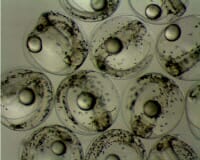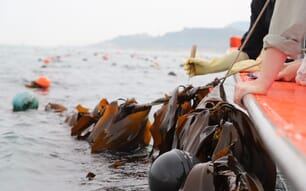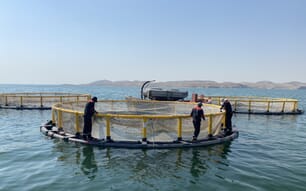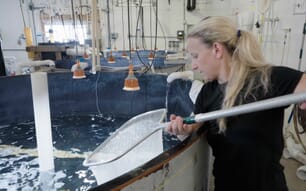Beginning on June 29th 2009, a captive-reared broodstock of Atlantic bluefin tuna maintained at the sea cage facilities of the SELFDOTT project partner Tuna Graso, of the Ricardo Fuentes Group in Cartagena, Spain, began spawning after being implanted with a reproductive hormone delivery-system.
The fish spawned daily afterwards, producing a total of 140 million eggs by July 17th, with a daily maximum of 34 million eggs (3rd of July). A second captive-reared broodstock of Atlantic bluefin tuna maintained at the sea cage facilities of Mare Nostrum, Puglia, Italy, also began spawning 3 days after hormone delivery system implantation (30th June), producing a total of 46 million eggs over the course of two weeks.

The eggs produced at the two sites were sent to research hatcheries in Spain, France, Italy, Malta, Greece and Israel to commence for the first time the research on the larval rearing of this magnificent and unique marine fish.
The successful spawning in two different locations in the Mediterranean Sea, using the same broodstock management and spawning induction methods is a major success and an important step towards the domestication of the Atlantic bluefin tuna in the Mediterranean region, thus contributing to the conservation of the heavily exploited and seriously threatened wild stocks.
A third broodstock maintained at the sea cage facilities of Malta Fish Farming Ltd (Malta), was shown to have a significant improvement in gonad size and reproductive maturity status in response to a diet formulated specifically for tuna broodstocks by the Malta Centre for Fisheries Sciences (Malta).
However, no fertilized eggs were collected from this stock, probably due to high currents at the rearing site, pointing to the risks involved in maintaining broodstock in sea cages and the need for the development of a dedicated land-based broodstock facility for the Atlantic bluefin tuna.

Photo: F.L.M./N.Atlantis
The captive broodstocks maintained in Spain and Malta, belong to a European research consortium (SELFDOTT) funded by the 7th Framework Programme of the European Commision (KBBE-2007-1-2-09 Cooperation Work Programme: Food, Agriculture and Fisheries, and Biotechnology, 3 million euro) and coordinated by Dr. Fernando de la Gándara of the Murcia Oceanographic Center, belonging to the Instituto Español de Oceanografia (IEO).
The captive broodstock maintained in Italy belongs to a regional research consortium (ALLOTUNA) funded by European Union Structural Funds through the region of Puglia (Accordo di Programma Quadro in Materia di Ricerca Scientifica nella Regione Puglia, 2 million euro), and is coordinated by Professor Gregorio De Metrio of the Department of Animal Health and Welfare, the University of Bari, Italy.
The two research consortia have some common partners, and have signed a collaboration agreement and coordinate their activities closely, in order to maximize the utilization of resources and ensure the success of their objective, which is the domestication of the Atlantic bluefin tuna in the Mediterranean. Tunas constitute the most valuable fishery worldwide, with global catches in 2002 of 9 million mtn and a value of US$ 6 billion.
Fuelled by the increasing demand for this unique fish by the sashimi-sushi market in Japan, Europe and the United States, a “capture-based" aquaculture industry has developed in the Mediterranean Sea over the last decade, which involves the capture of migrating wild fish and their fattening in floating cages for periods ranging from 2 months to 2 years.

Photo: Fernando de la Gándara
The dramatic expansion of this industry is considered a threat to the now heavily over-fished wild stock. As a result, the International Commission for the Conservation of Atlantic Tunas (ICCAT), the international organization responsible for the conservation of tunas in the Atlantic Ocean and its adjacent seas, is implementing a 50 per cent, 4-year gradual reduction in the Total Allowable Catch (TAC) for Eastern Atlantic and Mediterranean bluefin tuna, in an effort to address the increasing concern of scientists and non-governmental organizations over the status of the wild stocks and the threat of extinction of the species due to overfishing (see also www.wwf.com; www.panda.org; www.grenpeace.org).
In an effort to alleviate the pressure on the Atlantic bluefin tuna fishery and aid in the conservation of this magnificent and historically important species for the economies of societies in the Atlantic Ocean and Mediterranean Sea regions, the European Union, has funded the SELFDOTT and ALLOTUNA projects, which aim at the development of a selfsustained aquaculture industry for Atlantic bluefin tuna, which will be independent of the wild populations for seed.
The major research effort to accomplish this goal include (a) control of reproduction of this species in captive conditions, (b) rearing of the larvae and production of adequate numbers of juveniles for grow-out and (c) development of suitable, scientifically formulated and environmentally performing feeds.
The massive daily spawning of fertilized eggs achieved this year under controlled conditions in two different locations in the Mediterranean region was achieved via proper broodstock nutrition, monitoring of ambient water temperature and weather conditions, and use of a reproductive hormone delivery system (implant) already developed for inducing spawning in bluefin tunas, in the frame work of another EU-funded research programme (REPRODOTT).
The implant was developed by the SELFDOTT partners Hellenic Center for Marine Research (Crete, Greece) and the Heinrich- Heine University of Düsseldorf (Germany), and contains a synthetic agonist of Gonadotropin- Releasing Hormone (GnRHa), the hormone responsible for controlling the production and release of the natural gonadotropins in all vertebrates and is commonly used in human Assisted Reproduction Protocols.
The implant is administered underwater into the fish's muscle, while the broodstock are swimming in the rearing cage, using a specially modified spear-gun or jab-stick. The GnRHa is released into the blood slowly over the course of two weeks, inducing release of the gonadotropins and resulting in ovulation, spermiation and spawning in daily cycles.
The spawned Atlantic bluefin tuna eggs where restrained inside the rearing cage by placing a specially designed egg collecting system or a retaining curtain around the perimeter of the broodstock cage.
From the surface of the cage, the floating eggs were collected using finemesh nets in the early morning hours and were packaged properly and shipped by either car, train or airplane to the larval rearing sites of the partners of the SELFDOTT and ALLOTUNA projects in Spain (Puerto de Mazarron, IEO), France (Palavas, Institut Français d’Exploitation de la Mer, IFREMER), Italy (Panittica Pugliese), Greece (Crete, HCMR) and Israel (Eilat, National Centre for Mariculture, NCM-IOLR).
The larval rearing experiments are progressing well and many Atlantic bluefin tuna larvae ranging in age from 12 to 20 days old are growing steadily under different environmental and feeding regimes. Given the fast growth rate of Atlantic bluefin tuna, it is expected that the larval rearing phase will be completed at 30 days after hatching, at which time the juveniles may be moved to sea cages for on-growing, or be maintained in the hatchery for further experimentation.
The other consortium members of SELFDOTT include the University of Cádiz, (Spain), the Centre National pour la Recherche Scientifique (CNRS, France), the Université de Montpellier II, (France) and Skretting Aquaculture Research Centre (SARC, Norway), belonging to the multinational feed company Nutreco.
The other consortium members of ALLOTUNA include two private companies (Panittica Pugliese and Franco Scarciglia Pesca Acque Marine, both located in Puglia) and one regional stakeholder organisation (Associazione Armatori da Pesca di Molfetta).
The successful spawning and acquisition of viable eggs of Atlantic bluefin tuna from captive individuals is the first and extremely important step in the domestication of the Atlantic bluefin tuna in the Mediterranean region and the establishment of a sustainable, proper aquaculture industry, which will be independent of the wild populations, without having to exploit the already depleted natural stocks.
The success of the larval rearing trials is the next step, and is anticipated to be achieved in the coming years through the efforts of SELFDOTT and ALLOTUNA.
August 2009




